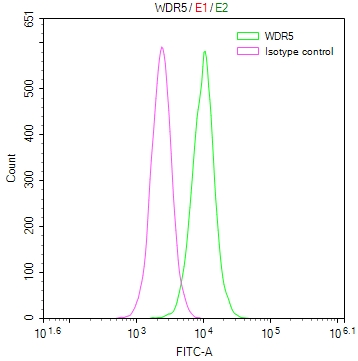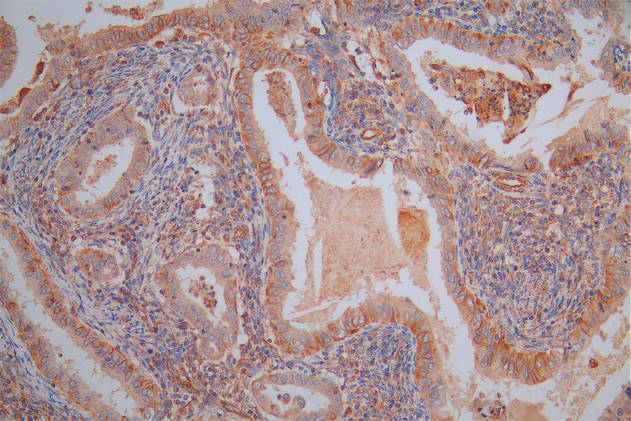SIX1 Antibody, FITC conjugated
-
中文名稱:SIX1兔多克隆抗體, FITC偶聯
-
貨號:CSB-PA618986LC01HU
-
規格:¥880
-
其他:
產品詳情
-
產品名稱:Rabbit anti-Homo sapiens (Human) SIX1 Polyclonal antibody
-
Uniprot No.:
-
基因名:SIX1
-
別名:BOS3 antibody; DFNA23 antibody; Homeobox protein SIX1 antibody; OTTHUMP00000179042 antibody; Sine oculis homeobox homolog 1 antibody; SIX homeobox 1 antibody; SIX1 antibody; SIX1_HUMAN antibody; TIP39 antibody
-
宿主:Rabbit
-
反應種屬:Human
-
免疫原:Recombinant Human Homeobox protein SIX1 protein (144-262AA)
-
免疫原種屬:Homo sapiens (Human)
-
標記方式:FITC
-
克隆類型:Polyclonal
-
抗體亞型:IgG
-
純化方式:>95%, Protein G purified
-
濃度:It differs from different batches. Please contact us to confirm it.
-
保存緩沖液:Preservative: 0.03% Proclin 300
Constituents: 50% Glycerol, 0.01M PBS, pH 7.4 -
產品提供形式:Liquid
-
儲存條件:Upon receipt, store at -20°C or -80°C. Avoid repeated freeze.
-
貨期:Basically, we can dispatch the products out in 1-3 working days after receiving your orders. Delivery time maybe differs from different purchasing way or location, please kindly consult your local distributors for specific delivery time.
-
用途:For Research Use Only. Not for use in diagnostic or therapeutic procedures.
相關產品
靶點詳情
-
功能:Transcription factor that is involved in the regulation of cell proliferation, apoptosis and embryonic development. Plays an important role in the development of several organs, including kidney, muscle and inner ear. Depending on context, functions as transcriptional repressor or activator. Lacks an activation domain, and requires interaction with EYA family members for transcription activation. Mediates nuclear translocation of EYA1 and EYA2. Binds the 5'-TCA[AG][AG]TTNC-3' motif present in the MEF3 element in the MYOG promoter and CIDEA enhancer. Regulates the expression of numerous genes, including MYC, CCND1 and EZR. Acts as activator of the IGFBP5 promoter, probably coactivated by EYA2. Repression of precursor cell proliferation in myoblasts is switched to activation through recruitment of EYA3 to the SIX1-DACH1 complex. During myogenesis, seems to act together with EYA2 and DACH2. Regulates the expression of CCNA1. Promotes brown adipocyte differentiation.
-
基因功能參考文獻:
- SIX1 glycolytic function is directly repressed by microRNA-548a-3p, which is downregulated, inversely correlates with SIX1, and is a good predictor of prognosis in breast cancer patients PMID: 29455928
- Knockdown of SIX1 increased cell ROS levels and autophagy, promoted cell apoptosis, and enhanced TAX sensitivity of HepG2 cells. PMID: 29656300
- SIX1/EYA1 mutations might be partially responsible for conotruncal heart defects. PMID: 29043394
- We replicated the association of SNP rs10483727 in the SIX1/SIX6 locus with POAG in a Saudi cohort, suggesting its role in increasing susceptibility to Primary Open Angle Glaucoma . PMID: 29190129
- SIX1 is a potential target gene of miR-30a and down-regulation of SIX1 by siRNA inhibited proliferation and invasion of prostate cancer cells. PMID: 28573504
- Six1 is overexpressed in human primary pancreatic ductal adenocarcinomas and that its inhibition results in a decreased tumour progression in vitro and in vivo. PMID: 28388884
- in non-small cell lung cancer, SIX1-5 were associated with the greater possibility of the tumorigenesis PMID: 27821176
- SIX1 oncoprotein is aberrantly expressed in the endometrium following developmental exposure to estrogenic chemicals, correlates with uterine cancer, and is a biomarker in human endometrial cancers PMID: 27259717
- SIX homeobox 1 (SIX1) regulates cellular senescence by a p16INK4A (p16)-dependent mechanism. PMID: 26500063
- Studies strongly suggest that Six1 overexpression promotes CRC growth and metastasis and remodels tumor stroma by stimulating angiogenesis and recruiting TAM. MAPK activation may be a pivotal event in Six1-associated tumor progression. PMID: 28199476
- Restoration of SIX1 was sufficient to abolish proliferation, migration and invasion induced by miR-362 overexpression in cervical cancer cells. The newly identified miR-362/SIX1 pathway provides insight into cervical cancer progression, and may represent a novel therapeutic target. PMID: 27878258
- study replicated the association of POAG with two SNPs at the SIX1-SIX6 locus and demonstrated that SNPs, rs10483727 and rs33912345, are significantly associated with POAG, especially with NTG in patients aged above 40 years PMID: 27260188
- results suggest that SIX1 is a key proliferation regulator in mouse DFCs and human PDLCs, which provides novel insight into Six family gene function in mammals. PMID: 27241908
- miR-188 suppresses proliferation and invasion by targeting SIX1 in oral squamous cell carcinoma cells. PMID: 26490981
- Upregulation of Six1 could downregulate miR-204-5p expression. PMID: 26408179
- Mutations of SIX1 gene underlie Wilms tumor recurrences. PMID: 26802027
- Six1 signaling has a role in paclitaxel-dependent apoptosis in MCF-7 cell line PMID: 26773176
- Six1 mutations/gene deletion are unlikely to be a major cause of nonsyndromic CAKUT. PMID: 24899122
- Data show that the protein domain interfaces may represent therapeutic targets in homeo domain protein SIX1-positive Hodgkin lymphoma (HL) subsets. PMID: 26473286
- Data show that both Ezrin and SIX1 proteins are highly expressed in alpha fetoprotein-negative hepatocellular carcinoma (HCC) and significantly related with the TNM stage. PMID: 26927385
- These data suggest differential SIX-factor regulation might have contributed to species differences in nephron progenitor programs such as the duration of nephrogenesis and the final nephron count PMID: 26884396
- Single nucleotide polymorphism in SIX1 gene is associated with primary open angle glaucoma. PMID: 25798827
- High expression of SIX1 is an independent prognostic marker in colorectal cancer. PMID: 25951369
- Three causative genes for BOR syndrome have been reported thus far: EYA1, SIX1, and SIX5, but the causative genes for approximately half of all BOR patients remain unknown.[review] PMID: 24730701
- SIX1 and EYA are often co-overexpressed in tumors, and the SIX1-EYA2 interaction has been shown to be critical for metastasis in a breast cancer model. PMID: 25555392
- Six1 plays an important role in the TIC population in luminal breast cancers and induces a TIC phenotype by enhancing both TGF-beta and ERK signaling. PMID: 22765220
- SIX1 plays an important role in the progression ofhepatocellular carcinoma PMID: 25031720
- in tumors with DGCR8 E518K and DROSHA exon 29 (miRNAPG-HS) mutations ... greater prevalence of tumors with blastemal predominant histology in patients with miRNAPG-HS and/or SIX1/2 Q177R mutations PMID: 25670082
- Recurrent mutations included a hotspot mutation (Q177R) in the homeo-domain of SIX1 and SIX2 in tumors with high proliferative potential (18.1% of blastemal cases); mutations in the DROSHA/DGCR8 microprocessor genes PMID: 25670083
- Six1 overexpression in HPV16-immortalized keratinocytes increased cell proliferation and promoted cell migration and invasion by inducing epithelial-mesenchymal transition. PMID: 25463612
- HDAC5 promoted the Six1 expression. PMID: 24706304
- tumor cells that expressed high levels of SIX1 could promote lymphangiogenesis and counteract the negative effects of TGFbeta on lymphangiogenesis by increasing the expression of VEGF-C PMID: 25142796
- Results suggest that the increase of SIX1 expression could promote tumorigenesis, progression and invasive growth of cervical cancer by promoting DNA replication. PMID: 24970368
- In breast phyllodes tumors, Six1 and Pax3 expression is correlated with tumour grade, unfavourable clinicopathological parameters and poorer clinical outcome, suggesting that both proteins may play a role in malignant progression. PMID: 24438019
- SIX1 was frequently upregulated in gastric adenocarcinoma specimens and its overexpression could potentially be used as an independent predictor of prognosis and survival time in patients with gastric cancer PMID: 24866365
- Suggest that lentivirus-mediated Six1 inhibition may represent a novel therapeutic approach for treatment of colorectal cancer. PMID: 24551283
- Six1 promotes epithelial-mesenchymal transition and malignant conversion in human papillomavirus type 16-immortalized human keratinocytes. PMID: 24574515
- In colorectal cancer cells, SIX1 is a target gene for regulation of cell migration and tumor invasion. PMID: 24593661
- data suggested that Six1 might be involved in the promotion of growth, proliferation, and migration of osteosarcoma cell lines PMID: 24114014
- These results suggest that SIX1/alpha5beta1 might be considered as valuable marker for metastatic potential of cervical cancer cells, or a therapeutic target in cervical cancer treatment. PMID: 24613848
- SIX1 overexpression is associated with pancreatic ductal adenocarcinoma. PMID: 24263054
- these data suggest that Six1 may function as an important modifier of the paclitaxel response in breast cancer cells, and serve as a potential target for overcoming paclitaxel resistance in breast cancer. PMID: 24184484
- Six1 promotes proliferation of pancreatic cancer cells via upregulation of cyclin D1 expression. PMID: 23527134
- Given that SIX1 and EYA are overexpressed in many tumor types, our data indicate that targeting the SIX1-EYA complex may be a potent approach to inhibit tumor progression in multiple cancer types PMID: 23435380
- It is required downstream of Six1 to induce these phenotypes. PMID: 22286770
- SIX1 overexpression contributes to epithelial-mesenchymal transition partly through repression of miR-200-family expression and activation of ZEB1 in colorectal cancer. PMID: 22286765
- The identification of SIX1 and CDKN2B variant was found to be associated more strongly with advanced open-angle glaucoma. PMID: 22840486
- An exception is the predominant expression of SIX1 in blastemal cells, hereby identifying this protein as a candidate marker for blastema. PMID: 22180226
- In East Asian populations, a SIX1 mutation has been reported in a Japanese family with branchio-oto (BO) syndrome. PMID: 22447252
- A critical role for SIX1 in lymphatic dissemination of breast cancer cells, providing a direct mechanistic explanation for how VEGF-C expression is upregulated in breast cancer. PMID: 22466647
顯示更多
收起更多
-
相關疾病:Deafness, autosomal dominant, 23 (DFNA23); Branchiootic syndrome 3 (BOS3)
-
亞細胞定位:Nucleus. Cytoplasm.
-
蛋白家族:SIX/Sine oculis homeobox family
-
組織特異性:Specifically expressed in skeletal muscle.
-
數據庫鏈接:
Most popular with customers
-
YWHAB Recombinant Monoclonal Antibody
Applications: ELISA, WB, IHC, IF, FC
Species Reactivity: Human, Mouse, Rat
-
-
-
-
-
-
-



















